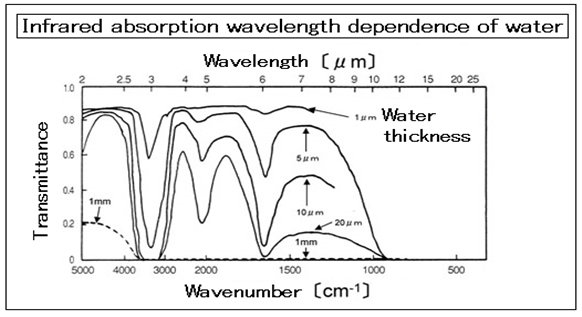INDEX
5-1-1.Water will absorb the infrared.
The difference between the absorption rate by the wavelength of infrared Although there are, as shown in the figure below, the thickness of the water film it absorb 100% infrared at any wavelength and more than 1mm.
Absorbed infrared in water to excite the electrons in the water, it attempt to evaporation from a liquid to a gas.
化学技術誌MOL, pp.120-128, 昭和63年2月.
5-1-2.The infrared heating, it is a way of electrical energy to heat the object is converted to electromagnetic waves.
Energy heat flux due to infrared heating, is expressed in the following equation.
q : heat flux
ε: emissivity = absorptivity
σ: Stefan-Boltzmann constant(5.67x10^-8 W/m^2/K^4)
T : temperature difference
Effect of infrared heating is proportional to the fourth power of the difference between the temperature of the heating filament and the object.
Tungsten filament of the halogen heater is overwhelming temperature difference reached a maximum temperature 3150K.
The figure below is the spectral distribution due to the color temperature, is the ratio the efficiency of the integral value of the integral value and the overall spectral characteristics of the wavelength range of 7μm from 4μm.
As in the table below of Wien’s displacement law, and heater output increases, wavelength in the near infrared is displaced.
Inevitably, infrared heater of high output, will be the thing of the near-infrared region.
5-1-3.As is to Wien’s displacement law, a high output heater is limited to virtually near-infrared method.
Among them, the halogen heater, the proportion is 85% of the electrical energy is converted to electromagnetic waves, is the most efficient heating.
Halogen heater as shown in the figure below and then irradiated with near-infrared the 1μm as a central value.
